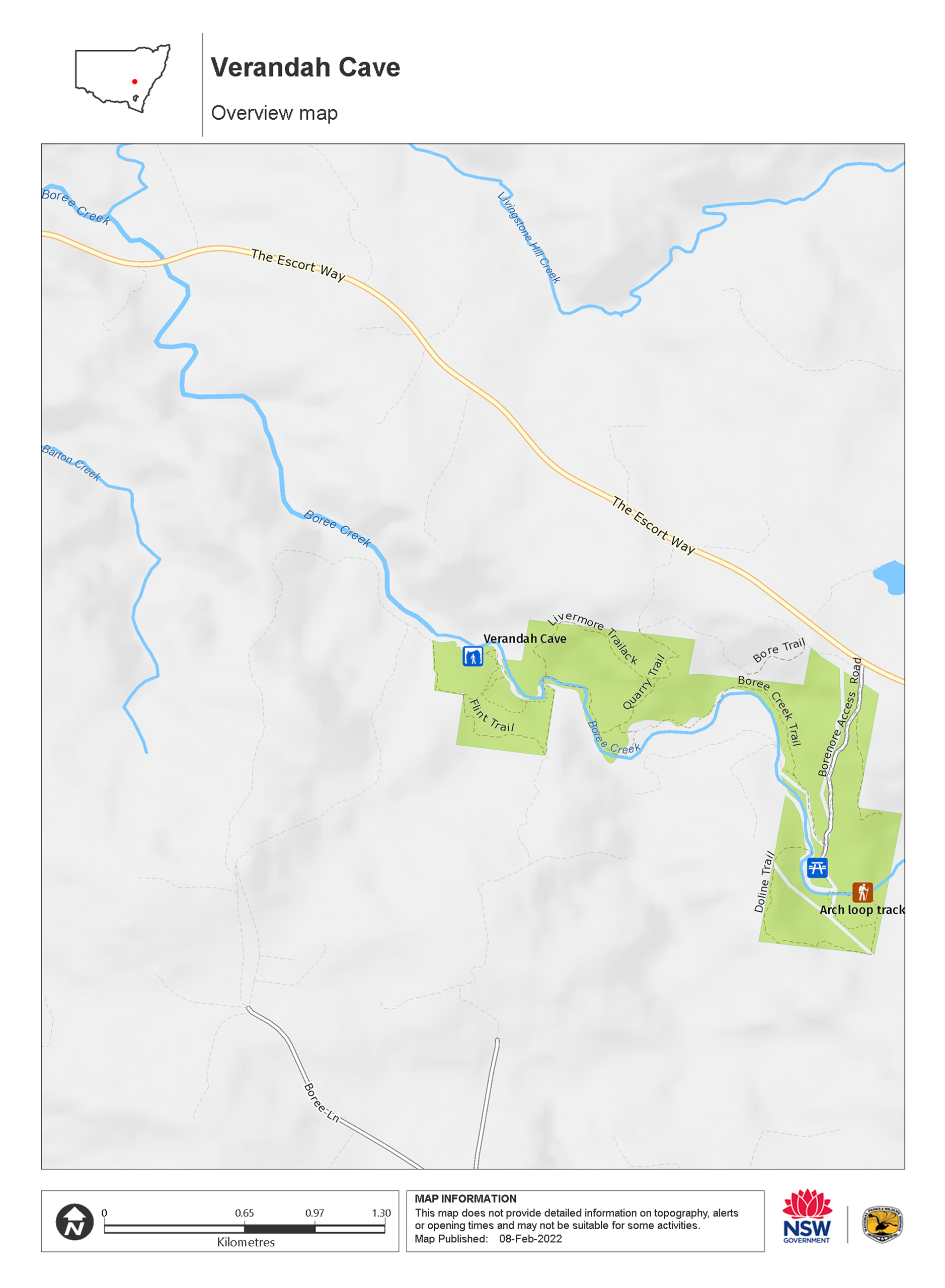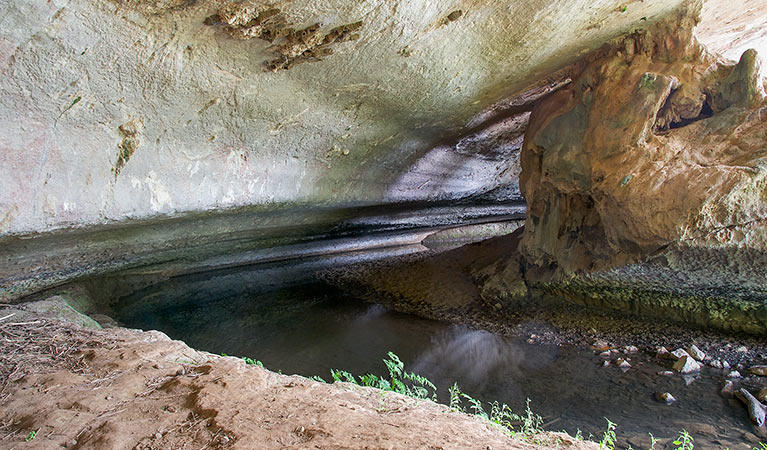Overview
Take the easy walk from Borenore picnic area to Verandah Cave, where you can explore its limestone outcrops and pools of water in Borenore Karst Reserve.
- Type
- Show caves
- Opening times
Borenore picnic area, from where you set out for Verandah Cave, is open from 9am-7pm every day, but may have to close at times due to poor weather or fire danger.
- What to
bring - Drinking water
An hour’s hike from Borenore picnic area you’ll find Verandah Cave, a large limestone overhang protecting large pools of water. Located near Orange, it’s a great destination for a weekend getaway or a stretch of the legs on a car tour along Borenore trail.
It’s a pleasant 7km return journey along Boree Creek trail, over mainly flat ground and through the bush. You’ll see yellow box gum and apple box trees, and possibly even eastern grey kangaroos.
Explore the rocky outcrops formed over thousands of years by fast-moving water. If you’re very quiet, you might be lucky to see a platypus, although they are very shy. The cave is a shady, relaxing place to unpack a picnic, or to enjoy a leisurely lunch beside the tranquil Verandah Creek.
Map

Map legend

Local alerts
For the latest updates on fires, closures and other alerts in this area, see https://www.nationalparks.nsw.gov.au/things-to-do/show-caves/verandah-cave/local-alerts
Park info
- in Borenore Karst Conservation Reserve in the Country NSW region
Borenore Karst Conservation Reserve is open 9am to 7pm every day but may have to close at times due to poor weather or fire danger.
Visitor info
All the practical information you need to know about Verandah Cave.
Getting there and parking
On entering Borenore Karst Conservation Reserve, drive 1km to Borenore picnic area. Boree Creek trail starts on the western side of the picnic area, where parking is available.
Road quality
Check the weather before you set out as the road to Borenore picnic area can become boggy when it rains
- Unsealed roads
Vehicle access
- 2WD vehicles
Weather restrictions
- All weather
Parking
Parking is available at Borenore picnic area and at the gate to Boree Creek trail. It can be a busy place on the weekend, when parking might be limited.
Best times to visit
There are lots of great things waiting for you in Borenore Karst Conservation Reserve. Here are some of the highlights.
Autumn
Let your inner geologist loose among the limestone and see if you can spot the remnants of marble quarries and mines from the past.
Spring
Check out the wildflowers and birds in the endangered box gum woodland.
Summer
Escape the heat and step into magical Arch Cave while walking the Arch Cave loop track.
Weather, temperature and rainfall
Summer temperature
Average
15°C and 25°C
Highest recorded
38.3°C
Winter temperature
Average
2°C and 12°C
Lowest recorded
-5.6°C
Rainfall
Wettest month
August
Driest month
April
The area’s highest recorded rainfall in one day
98.6mm
Facilities
You'll find toilets at Borenore picnic area.
Maps and downloads
Prohibited
Pets
Pets and domestic animals (other than certified assistance animals) are not permitted. Find out which regional parks allow dog walking and see the pets in parks policy for more information.
Smoking
NSW national parks are no smoking areas.
Learn more
Verandah Cave is in Borenore Karst Conservation Reserve. Here are just some of the reasons why this park is special:
Aboriginal connections

The permanent flow of Boree creek and the reliable shelter of caves meant that this area was used for thousands of years by the Wiradyuri people. In fact, the name 'Borenore' is believed to be derived from two Wiradyuri words: bora which means ceremony and nora nora meaning shelf or overhanging rock. The reserve remains an important place for Aboriginal people today and protects a number of ancient sites, including Arch Cave which is highly significant for local Aboriginal women as a maternity site.
From limestone to marble

Marvel at the stalactites and stalagmites at Borenore Karst Conservation Reserve. The karst or limestone, as it is better known in the reserve, probably began life as limey mud and coral reefs some 390-400 million years ago when the area was located off the east coast of Australia. Around 12 million years ago, nearby Mount Canobolas spewed lava over the limestone, turning it into marble. Borenore marble, known as Borenore Red, was used in many public buildings in Sydney, including Transport House in Macquarie Street, and countless marble fireplaces.
- Arch loop track Explore Arch Cave along the easy Arch loop track, a short walk from the picnic area. Look for stalactites, stalagmites and columns in the cool cavern.
- Verandah Cave Take the easy walk from Borenore picnic area to Verandah Cave, where you can explore its limestone outcrops and pools of water in Borenore Karst Reserve.
Mystical adventure

Home to the ancient Arch Cave, Borenore Karst Conservation Reserve harbours a whole world that thrives in the dark. Light up your head torch and marvel at the stalactites and stalagmites. Listen to the drips of water around you that keep the air moist, the perfect breeding ground for the mosses and lichen surrounding the entrance. The musky smell you will notice is the tell-tale sign that bats are about as the caves are a precious home to these protected species.
- Borenore picnic area With a large grassy area, barbecues and picnic tables, Borenore picnic area is a great place for a family picnic. After lunch, take an easy walk to explore Arch Cave.
Protecting the precious

Borenore Karst Conservation Reserve plays a special role in the preservation of some of Australia's precious native flora and fauna. A haven for birds, the park is home to thornbills, honeyeaters, kookaburras, magpies, treecreepers, weebills and more. Another special flying creature finding protection here is the eastern bent-winged bat, a threatened species that spends the winter hibernating in Tunnel Cave, before emerging in spring ready to migrate. Borenore Karst Conservation Reserve also contains the endangered box gum woodland vegetation community.
- Verandah Cave Take the easy walk from Borenore picnic area to Verandah Cave, where you can explore its limestone outcrops and pools of water in Borenore Karst Reserve.
Operated by
- Bathurst office
- Monday to Friday, 8.30am to 4.30pm.
- 02 6332 7640
- 02 6332 7680 To contact the KARST Conservation Unit in this office.
- npws.centralwest@environment.nsw.gov.au
- Level 2, 203-209 Russell Street, Bathurst NSW 2795
Park info
- in Borenore Karst Conservation Reserve in the Country NSW region
Borenore Karst Conservation Reserve is open 9am to 7pm every day but may have to close at times due to poor weather or fire danger.

